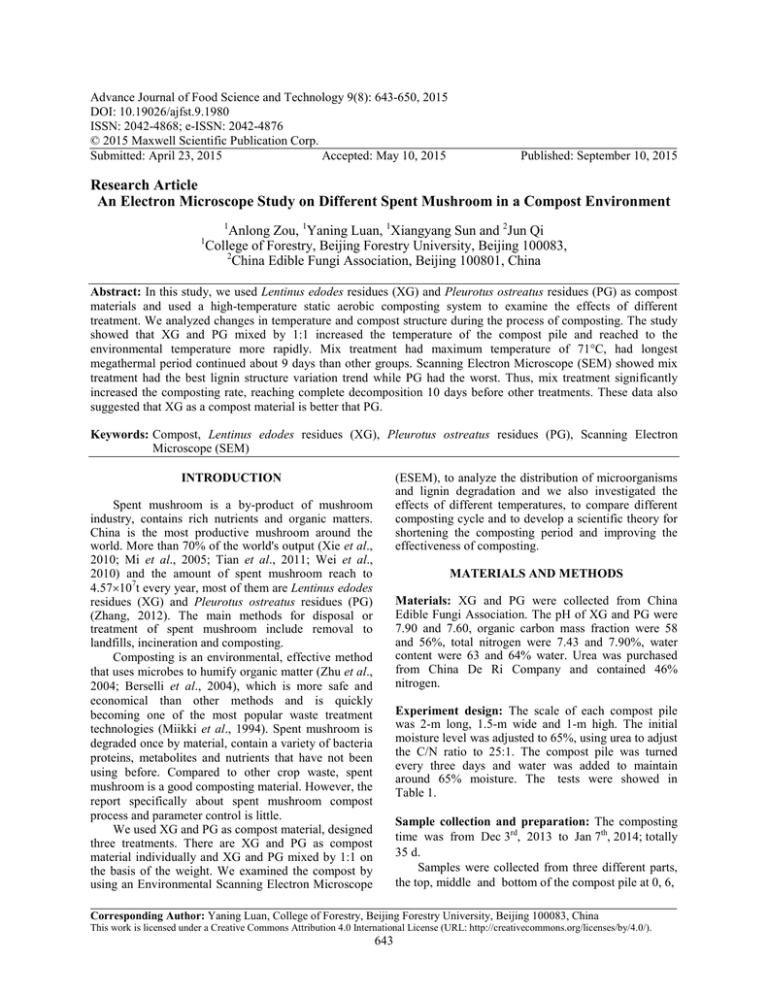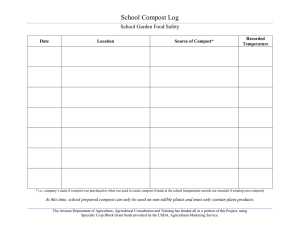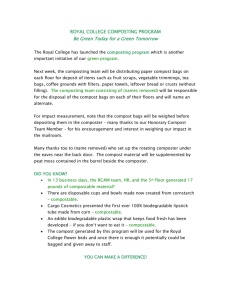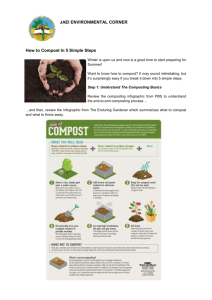Advance Journal of Food Science and Technology 9(8): 643-650, 2015
advertisement

Advance Journal of Food Science and Technology 9(8): 643-650, 2015 DOI: 10.19026/ajfst.9.1980 ISSN: 2042-4868; e-ISSN: 2042-4876 © 2015 Maxwell Scientific Publication Corp. Submitted: April 23, 2015 Accepted: May 10, 2015 Published: September 10, 2015 Research Article An Electron Microscope Study on Different Spent Mushroom in a Compost Environment 1 1 Anlong Zou, 1Yaning Luan, 1Xiangyang Sun and 2Jun Qi College of Forestry, Beijing Forestry University, Beijing 100083, 2 China Edible Fungi Association, Beijing 100801, China Abstract: In this study, we used Lentinus edodes residues (XG) and Pleurotus ostreatus residues (PG) as compost materials and used a high-temperature static aerobic composting system to examine the effects of different treatment. We analyzed changes in temperature and compost structure during the process of composting. The study showed that XG and PG mixed by 1:1 increased the temperature of the compost pile and reached to the environmental temperature more rapidly. Mix treatment had maximum temperature of 71°C, had longest megathermal period continued about 9 days than other groups. Scanning Electron Microscope (SEM) showed mix treatment had the best lignin structure variation trend while PG had the worst. Thus, mix treatment significantly increased the composting rate, reaching complete decomposition 10 days before other treatments. These data also suggested that XG as a compost material is better that PG. Keywords: Compost, Lentinus edodes residues (XG), Pleurotus ostreatus residues (PG), Scanning Electron Microscope (SEM) (ESEM), to analyze the distribution of microorganisms and lignin degradation and we also investigated the effects of different temperatures, to compare different composting cycle and to develop a scientific theory for shortening the composting period and improving the effectiveness of composting. INTRODUCTION Spent mushroom is a by-product of mushroom industry, contains rich nutrients and organic matters. China is the most productive mushroom around the world. More than 70% of the world's output (Xie et al., 2010; Mi et al., 2005; Tian et al., 2011; Wei et al., 2010) and the amount of spent mushroom reach to 4.57×107t every year, most of them are Lentinus edodes residues (XG) and Pleurotus ostreatus residues (PG) (Zhang, 2012). The main methods for disposal or treatment of spent mushroom include removal to landfills, incineration and composting. Composting is an environmental, effective method that uses microbes to humify organic matter (Zhu et al., 2004; Berselli et al., 2004), which is more safe and economical than other methods and is quickly becoming one of the most popular waste treatment technologies (Miikki et al., 1994). Spent mushroom is degraded once by material, contain a variety of bacteria proteins, metabolites and nutrients that have not been using before. Compared to other crop waste, spent mushroom is a good composting material. However, the report specifically about spent mushroom compost process and parameter control is little. We used XG and PG as compost material, designed three treatments. There are XG and PG as compost material individually and XG and PG mixed by 1:1 on the basis of the weight. We examined the compost by using an Environmental Scanning Electron Microscope MATERIALS AND METHODS Materials: XG and PG were collected from China Edible Fungi Association. The pH of XG and PG were 7.90 and 7.60, organic carbon mass fraction were 58 and 56%, total nitrogen were 7.43 and 7.90%, water content were 63 and 64% water. Urea was purchased from China De Ri Company and contained 46% nitrogen. Experiment design: The scale of each compost pile was 2-m long, 1.5-m wide and 1-m high. The initial moisture level was adjusted to 65%, using urea to adjust the C/N ratio to 25:1. The compost pile was turned every three days and water was added to maintain around 65% moisture. The tests were showed in Table 1. Sample collection and preparation: The composting time was from Dec 3rd, 2013 to Jan 7th, 2014; totally 35 d. Samples were collected from three different parts, the top, middle and bottom of the compost pile at 0, 6, Corresponding Author: Yaning Luan, College of Forestry, Beijing Forestry University, Beijing 100083, China This work is licensed under a Creative Commons Attribution 4.0 International License (URL: http://creativecommons.org/licenses/by/4.0/). 643 Adv. J. Food Sci. Technol., 9(8): 643-650, 2015 Table 1: Different composting treatments of spent mushroom compost Group Treatment Treatment group A (TGA) 100% XG Treatment group B (TGB) 50% XG+50% PG Treatment group C (TGC) 100% PG composting period and XG is more effective than PG when they composted individually. Temperature change during composting: Temperature is an very important index of compost stability (Wang, 2013); The Harmless Health Organization of China says that compost temperature should reach more than 55°C during composting and the compost should remain at this temperature for 5-10 d, in this way harmful microorganisms can be killed (Deportes et al., 1995) and that manure/feces are decomposed sufficiently such that they are no longer hazardous (Keynan et al., 1961). The change of temperature of compost is also reflecting changes in the microbial activity during composting. The change in compost may be related to oxidative decomposition of organic matter content. The temperature always show a rises firstly during the early composting process, continues to rise as composting progresses and then gradually falls, when the temperature reaches the Environmental Temperature (ET), the compost can be considered stabilized. Temperature changes for the three groups in this test were showed in Fig. 1. In Fig. 1, the three groups had similar trends, with an initial increase in temperature, followed by a decrease back to the Environmental Temperature (ET). The treatment group B reached at megathermal period at day 5, which was 2 days earlier than the other groups. The period of high temperature for treatment group B was also longer than that for any of the other groups (8-9 days). Moreover, the treatment group B had the highest temperature was 71°C, while treatment group A and C were 68 and 58°C, that’s means treatment group B could kill harmful microorganisms more thoroughly than other groups. The reason to cause these phenomenon was XG contains sawdust, which can increase air permeability and provide more oxygen for bacteria, but sawdust are lake of nutrient, while PG contains cottonseed hull, which impede air into the compost pile, but cottonseed hull are rich in nutrients for bacteria need. Treatment group B covered the shortage for each other when the two materials mixed. It’s likely due to the increase in thermophilic bacteria and these bacteria release large amounts of soluble sugar, organic acid and energy, contributing to the increased temperature of the compost. Late in the composting process, the temperature dropped rapidly in treatment group B, reaching the Environmental Temperature (ET) more quickly than the other groups. Treatment group B completed composting 10 days before the treatment group C and 5-6 days before treatment groups A. Therefore, from the temperature index, XG and PG mixed was more effective than they compost individually. 13, 20, 26 and 31 days after initiation of composting (n = 10 samples of 100 g each per sample site per time point). For each time, the 10 samples were mixed, yielding 1000 g of sample and the sample was then divided into four 250-g subsamples; one of these subsamples was used for analysis. 150 g was used for superficial analysis and the remaining 100 g was dried at a temperature of up to 105°C and prepared for electron microscope scanning. Process data: A special mercury thermometer inserted into the center of the compost pile vertically to measure the temperature, providing an accurate reflection of the internal temperature of the compost. At 10:00 and 14:00 h, the temperature was measured and these two measurements were used to determine the average daily temperature. For electron microscopy, fresh compost samples were incubated in a DHG-9123 electric wind dryer for 72 h and then placed on conductive adhesive. Samples were coated with gold for 45 s and subsequently analyzed using a Hitachi S3400 scanning electron microscope (Hitachi, Tokyo, Japan). Data analysis: All data were analyzed using Microsoft Excel 2013. RESULTS AND DISCUSSION Changes in the appearance of the compost: Superficial analysis is an effective tool to value the compost. Firstly, the compost was quite coarse, greenish and had a slight odor. Midway through the experimental period, the compost became more decomposed, with smaller particle sizes, agglomeration, less smell and a gradual change to a yellowish-brown color. Finally, at the end of composting, the temperature dropped to near room temperature and composts were flocculent, loosely packed and not prickly to touch. Composts also had no distinct smell and exhibited a dark brown color. These results were consistent with the appearance of finished compost, indicating the complete decomposition of the material. While the early progression in each group was similar, differences were observed in the time required for completion of composting. The treatment group A completed composting around day 28; in contrast, treatment group B completed composting around day 22, while treatment group C completed composting around day 32. Thus, these data suggested that XG and PG mixed as compost materials had the shortest Electron microscopy analysis of samples during the composting process: Scanning Electron Microscope 644 Adv. J. Food Sci. Technol., 9(8): 643-650, 2015 Fig. 1: Temperature changes during composting as affected by four treatments. Labeling of the groups is as shown in Table 1 645 Adv. J. Food Sci. Technol., 9(8): 643-650, 2015 Fig. 2: Scanning electron microscope images of the compost material structure during the heating period. Labeling of the groups is as shown in Table 1 646 Adv. J. Food Sci. Technol., 9(8): 643-650, 2015 Fig. 3: Scanning electron microscope images of the compost material structure during the megathermal period. Labeling of the groups is as shown in Table 1 (SEM) is a type of electron microscope that produces images of a sample by scanning it with a focused beam of electron (Karumi et al., 2014; Di Fiore et al., 2014; Li et al., 2014). We used it to analyze the material composition of the compost directly. Some studies have indicated that lignin structure will change from columnar or massive to lamellar and to mesh-like, when the lignin structure become porous and flocculent structure we can consider compost finished. By observing the distribution of microbes and the lignin structure in the three samples, we can determine which treatment has better result on the composting cycle. the figure, the materials appeared some crevices, that’s because microbes entered into the inside of the lignins and released chemical substances to degrade the lignin, when microbes intrude into the material, producing expansion and extrusion forces that can also accelerate the decomposition of the material.; The treatment group A had more obvious lamellar structure than treatment group C, while the treatment group B had a more meshlike structure. Guo and Li (2010) and Ling (1998) have indicated that unicellular bacteria, fungi and spores are spherical, while Actinomycetes, fungi and other filamentous fungi exhibit protonema-like shapes. Additionally, the number of microbes in the treatment group B was much higher than that in other groups, electron microscope images showed that spherical bacteria were predominant in the megathermal period consistent, with the temperature variation observed during the early analysis. Because thermophilic microorganisms were predominant, the temperature rose quickly, allowing the maximum temperature of treatment group B to exceed than in other groups. Some microbes cover the surface of the material, effectively promoting the degradation of the compost by secreting enzymes. Therefor the more microorganisms exist the more quick degradation rate of the material. The material structure of compost in the heating period: Figure 2 reflects the structural changes in the composting material during the initial composting phase. From the figure we can distinguish all materials and we know that all samples exhibited a relatively complete columnar and tabular structure. There did not have any microbes and the degradation rate of the material was relatively low. However, the amount of degradation was greater in treatment groups A and B than in treatment group C, for treatment A and B have much more granules than treatment group A and obvious spherical structures were observed. Thus, we concluded that the lignin degradation was higher in treatment groups A and B than in treatment group C. The material structure of compost in the cooling period: During this period, the structure of treatment group will become porous and flocculent, indicating further degradation of the material and accumulation of humus. From the figure we can see that treatment group B mainly appeared porous and flocculent structure while treatment group C still retained lamellar structure. Furthermore, there were more filamentous bacteria on the surface of treatment group B, while spherical The material structure of compost in the megathermal period: Compared with the initial period, the structure of the compost material exhibited dramatic difference in the megathermal period, with material having a mesh-like and lamellar structure rather than columnar or massive (Fig. 3). As showed in 647 Adv. J. Food Sci. Technol., 9(8): 643-650, 2015 Fig. 4: Scanning electron microscope images of the compost material structure during the cooling period. Labeling of the groups is as shown in Table 1 648 Adv. J. Food Sci. Technol., 9(8): 643-650, 2015 Fig. 5: Scanning electron microscope images of the compost material structure during the maturity period. Labeling of the groups is as shown in Table 1 649 Adv. J. Food Sci. Technol., 9(8): 643-650, 2015 different manual techniques of sharpening curettes through a scanning electron microscope: A randomized controlled experimental study. Int. J. Dent. Hyg., 13(2): 145-50. Guo, Y. and Y. Li, 2010. Electron microscopic scanningobservation of the survival and infection of metarhizium flavoiride on henosepilachna vigintioctomaculata. Acta Agr. Boreali-Sinica, 25(5): 220-222. Karumi, T., S. Tanaka and T. Tanji, 2014. Observation of the potential distribution in GaN-based devices by a scanning electron microscope. Microscopy (Oxf), 63(Suppl. 1): 122-123. Keynan, A., Y. Henis and P. Keller, 1961. Factors influencing the composition of the cellulosedecomposing microflora on soil crumb plates. Nature, 191: 307. Li, C., Z. Liu and H. Xie, 2014. Novel scanning electron microscope bulge test technique integrated with loading function. Rev. Sci. Instrum., 85: 103-709. Ling, H., 1998. The Electron Microscope Scanning about Beauveria Bassiana Infected Pine Moths. In: Huang, B. (Ed.), pp: 344-348. Mi, Q., S. Wang and J. Sun, 2005. Study on the comprehensive utilization of edible fugus waste material. Chinese Agr. Sci. Bull., 21(2). Miikki, V., K. Hanninen, J. Knuutinen, J. Hyotylainen and R. Alen, 1994. Characterization of the humic material formed by composting of domestic and industrial biowastes. Part 1. HPLC of the cupric oxide oxidation products from humic acids. Chemosphere, 29: 2609-2618. Tian, B., L.H. Shi, X.F. Wang, D.M. Liu and H.H. Feng, 2011. Effect of spent mushroom compost on soil quality and turf growth. Chinese J. Grassland, 29(5). Wang, S., 2013. Effects of mushroom residue and straw on aerobic composting of sewage sludge. Jiangsu J. Agr. Sci., 29(2): 324-328. Wei, Z., G. Zhou and Q. Hu, 2010. Research and utilization of edible fungi residue. Edible Fungi China, 29(5): 3-6. Xie, F., K.L. Wei, J.J. Chen and S.X. Zhang, 2010. Effects of mushroom residue on soil microorganism amount and soil enzyme activity. Hunan Agr. Sci., 5: 54-58. Zhang, Y., 2012. Effects of Lentinus Edodes Residues and Pleurotus Ostreatus Residues on Soil Organic Matter, N and Total Phosphorus Amount. Guang Dong Agricultural Science, Retrieved from: http://en.cnki.com.cn/Article_en/CJFDTOTALGDNY201213023.htm. Zhu, N., C. Deng, Y. Xiong and H. Qian, 2004. Performance characteristics of three aeration systems in the swine manure composting. Bioresource Technol., 95: 319-326. bacteria decreased because much of the spherical bacteria in the inside of the material degraded the material. Additionally, with the temperature of the compost pile dropped. Actinomycetes can survive and proliferate in the appropriate conditions, which will accelerate decomposition. In Fig. 4, spherical bacteria increased in treatment groups C, indicating that compost pile would be accelerated decomposition. The material structure of compost in the maturity period: In Fig. 5, the structure of the treatment groups resembled irregular fluff, that’s means compost had reached maturity. Microbes can hardly see on the surface. The result may be insufficient energy in compost piles, which can lead to inadequate anabolism by microbes, resulting in decreased biomass on the surface of the material. We found that the materials of treatment groups coagulated together, for accumulation of humus. The structure of treatment group A and B appeared flocculent completely, while treatment group C still had porous survived. These data showed treatment group A and B finished compost more quick than treatment group C. CONCLUSION From all data we analyzed above, we can summarize treatment group B reached the maximum temperature of 71°C (treatment group A was 68°C, treatment group C was 58°C) and continued about 9 days, which means harmful microorganisms can be killed completely and the SEM showed treatment group A and B had better structure changes during compost. Our data, together with those of other studies cited herein, showed that compost piles could shorten the compost cycle and accelerate the composting process. XG had better effective than PG. Further, when they were mixed by 1:1, the composting time could be reduced by about 10 days. ACKNOWLEDGMENT This study was supported by the Fundamental Research Funds for the Central Universities (NO. YX2013-09). REFERENCES Berselli, S., G. Milone, P. Canepa, D. Di Gioia and F. Fava, 2004. Effects of cyclodextrins, humic substances and rhamnolipids on the washing of a historically contaminated soil and on the aerobic bioremediation of tshe resulting effluents. Biotechnol. Bioeng., 88: 111-120. Deportes, I., J.L. Benoit-Guyod and D. Zmirou, 1995. Hazard to man and the environment posed by the use of urban waste compost: A review. Sci. Total Environ., 172: 197-202. Di Fiore, A., S. Mazzoleni, F. Fantin, L. Favero, M. De Francesco and E. Stellini, 2014. Evaluation of three 650








